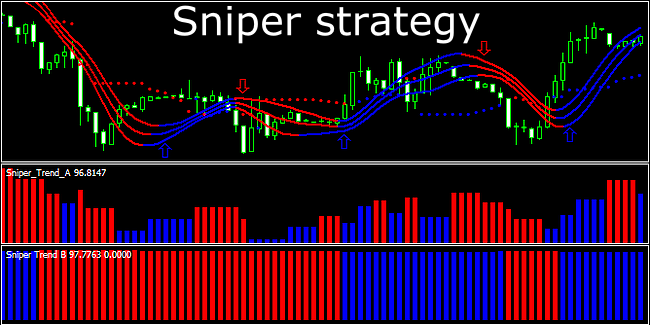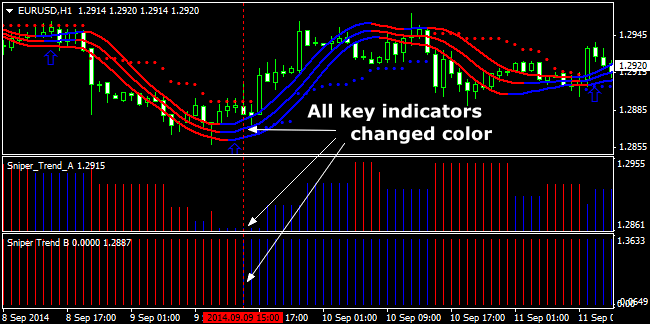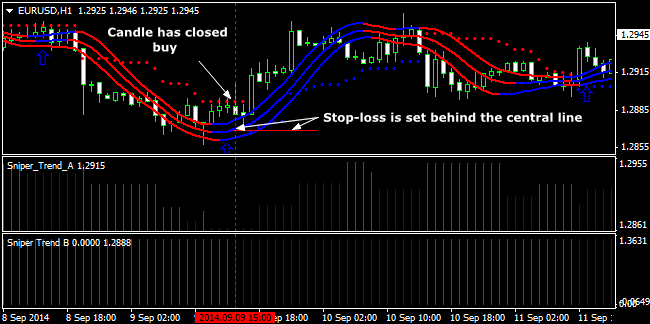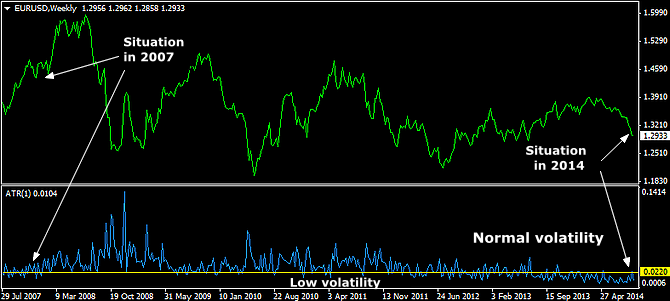
You can find a number of trading strategies called "Sniper" online, but today we will talk about the cognominal system on the indicators, as it is easy to use and, incredible as it may seem, is unique, because it is built on its own formulas and does not copy the pattern of other traders.
Despite its age (about 7 years), the Sniper strategy is still not without reason attracting the attention of speculators. Firstly, it is perfect for both intradayers and positioners. Secondly, the work does not impose any strict limitations on trading tools, although initially the algorithm was designed for the British pound. And thirdly, there are a few advisors on the basis of the system of indicators today.
Sniper strategy and working indicators
You can find several versions of this method online, with various additions, modifications, and even scripts, but the pattern for the base and concurrently the most reliable version will include a set of the following indicators:
- Sniper - a combination of moving averages, presented on the chart in the form of three lines and giving audible signals when the notification is on
- Sniper Stop –a modification of the standard Parabolic SAR, which points have been assigned different colors for the bullish and bearish market. Intended for setting the stop-loss and trailing positions;
- Sniper Trend A and Sniper Trend B – special charts in the "basement" windows.

To make deals to buy, several conditions must be met. Firstly, all moving averages must change the color to blue. Please note – the deal is made in a short time after the color change, this approach allows you to catch a trend reversal in the beginning, but if you enter the market after a long time after the reversal of the movings, there is a high probability to buy the high.
Secondly, both Sniper Trend histograms must also change the color to blue. At that, you won’t be able to use the tactics characteristic of many histogram indicators and suggesting to buy the instrument at the moment when a new histogram bar closed above the previous few.
This is due to the calculation formula, which is built taking into account the extremes and in reality is not as simple as it may seem, so making deals by a color change in this case is not something primitive for lazy traders – in contrast, is a simplified representation of complex calculations. The figure below shows an example to buy (the combination of signals will be completely the opposite for the deals to sell):

As it can be seen, in this case Parabolic remained red, and the obligatory change of color was not mentioned above. In fact, the question of whether to wait for the change of direction of the Parabolic SAR is quite controversial, according to disputes arising in the traders’ communities.
On the one hand, if you use the standard SAR “in the vacuum", then of course you need to wait, otherwise it makes no sense, but on the other hand, the Sniper strategy gives accurate signals without such confirmation, so there is no point in wasting the extra points at the entry because of the possible delay of signals.
Sniper strategy and some of the nuances associated with the placement of stops and take-profits
As you might have guessed, the main problem occurs when you set a stop-loss – in particular, in the above example you won’t be able to put a stop-loss behind the Sniper Stop, as it has not changed direction yet. But the central moving average is delayed not so strong and allows to set shorter and more accurate stops, therefore being an excellent alternative.

Thus, you can use any variant for initial calculation of the risk and further trailing positions. Note that in this case much will depend on the trading instrument: for example, on the euro, flat on which is a frequent occurrence, you can use the method with to the moving average, while for a good trend rates SAR is good, and the original system suggests the same.
The last thing to pay attention to is the profit target. The authors recommend the split position into parts, each of which have their values of take-profit set (uniform breakdown by the number of points), while after working out the first order the stop-loss must be set on all outstanding transactions to the breakeven. In our opinion, this approach is only partially correct, since the very idea of the breakdown is entirely correct and tactically successful, but the problems can occur with the levels.
The Sniper strategy was created in 2007, which is already alarming for the experienced speculators, and it is not even about the subsequent crisis, which broke out after a year: the real problem is much more dangerous and is a consequence of the changing nature of the market. The figure below shows the weekly chart of EUR/USD and ATR with the period of calculation of one week:

Thus, today the market is completely different and is in a phase of low volatility, so if in 2007 the profit fixed at the level of, for example, 100 points before the trend change was triggered, today the price may fail to go that far. Consequently, the transaction is better to break into two parts and then accompany the position as follows:
- to set the take for one half in points, taking into account the volatility of the last month;
- after working out the first target, to move the stop on the second one to the breakeven and fix the profit after the opposite signal according to the rules of the system, i.e. manually after the change of the trend
Strengths and weaknesses inherent in the Sniper strategy
In conclusion, we should note that even the simple at first glance Sniper strategy, for which the parameters of the main indicators cannot be corrected by default (if you do not edit the code), carries both hidden opportunities and dangers. In particular, the following advantages specific to the considered strategy can be formulated according to the results of this review:
- Low risk: according to historical data, the stop-loss is rarely much higher than the potential profit;
- Simple and unambiguous rules that allow to collect and analyze statistics on the history of transactions;
- There is no strict limit on the working timeframe, though there are instructions where the hour is recommended, which, in our opinion, creates artificial constraints;
- The availability of audio signals on the main indicator (moving averages), which simplifies trading and takes less time.
The main drawback is that there are many indicators for this type of system – for example, histogram reading could be combined into a single code, thus preventing the distracting of the trader’s attention. In addition, there are some difficulties with the Sniper Stop: in practice, in some cases it becomes useless and leads to unnecessary losses of Parabolic SAR delays. Source: Dewinforex
Social button for Joomla


